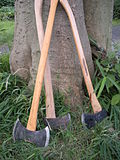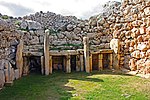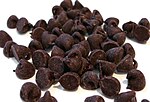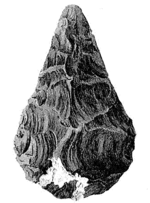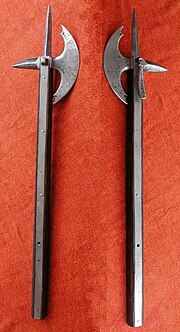In archaeology a chopping tool is a stone tool. Stone tools are usually dated by determining the age of the find context e.g. by carbon-14 dating and potassium–argon...
5 KB (689 words) - 12:55, 20 October 2024
Stone tools have been used throughout human history but are most closely associated with prehistoric cultures and in particular those of the Stone Age...
35 KB (3,989 words) - 23:09, 3 November 2024
Axe (redirect from Axe (tool))
doors and windows. Crash axe: A short lightweight handheld emergency chopping tool with a sharp or serrated blade spanning a quarter circular from the...
32 KB (3,728 words) - 03:49, 30 October 2024
a lifetime supply of chocolate. Initially, Nestlé included a small chopping tool with the chocolate bars. In 1941, Nestlé and at least one of its competitors...
5 KB (605 words) - 22:27, 4 October 2023
Pickaxe (redirect from Pick (tool))
hoeing, skimming, and chopping through roots. Developed as agricultural tools in prehistoric times, picks have evolved into other tools such as the plough...
6 KB (643 words) - 13:14, 20 October 2023
Hand axe (section Tool stone and cortex)
elaborated chopping tools and partial hand axes are linked and it is often difficult to distinguish between them. The concept of chopping tools is based...
106 KB (12,479 words) - 13:46, 31 October 2024
site lacks sophisticated choppers, hand axes, or any other complex chopping tool characteristic of the Acheulean of Western Eurasian and African sites...
55 KB (7,015 words) - 17:10, 21 October 2024
The Pulaski is a specialty hand tool used in fighting fires, particularly wildfires, which combines an axe and an adze in one head. Similar to a cutter...
4 KB (404 words) - 07:39, 25 July 2023
tribes of Mindanao, Philippines. It was also used as an agricultural or chopping tool. It ranges in size from 60 to 120 cm (2 to 4 ft) and usually 85 cm (33 in)...
26 KB (3,471 words) - 22:22, 25 October 2024
to great effect, making for a nimble, agile tool. In general, a forward-balanced blade excels at chopping but sacrifices agility and ease of manipulation;...
7 KB (1,220 words) - 23:01, 19 May 2024
Mattock (category Mechanical hand tools)
A mattock (/ˈmætək/) is a hand tool used for digging, prying, and chopping. Similar to the pickaxe, it has a long handle and a stout head which combines...
8 KB (938 words) - 08:46, 23 October 2024
Area, a UNESCO World Heritage Site, features a collection with remnants of tools that document the development and use of transitional technology. The indigenous...
187 KB (18,223 words) - 21:22, 2 November 2024
shape, and was initially intended for artillerymen and engineers as a chopping tool as well as a weapon. Towards the end of World War I, the 250 mm (9.8 in)...
64 KB (8,130 words) - 14:47, 5 November 2024
look like tools, damage or weathering of the “working” edge of said tools, having attributes that were similar to the making of chopping tools, and scarred...
16 KB (1,701 words) - 01:37, 22 September 2024
there included flint chopping tools, flint flakes and the tip of a worked wooden shaft, the Clacton Spear. Further examples of the tools have been found at...
10 KB (1,022 words) - 16:37, 19 October 2024
katti is mostly a chopping tool, a very common weapon found worldwide. It was used for clearing the forest, as an agricultural tool, as well as melee...
7 KB (692 words) - 03:17, 26 February 2023
timber framers. Twybil – Hand tool used for chopping out mortises in green woodworking Barlow, Ronald (1985). The Antique Tool Collector's Guide to Value...
2 KB (176 words) - 18:15, 5 October 2021
Zhanmadao (redirect from Horse-chopping saber)
(Chinese: 斬馬刀; pinyin: zhǎnmǎdāo; Jyutping: zaam2 maa5 dou1; lit. 'horse chopping saber') was a single-bladed anti-cavalry Chinese sword. It originated during...
5 KB (453 words) - 21:39, 22 October 2024
They were tool users rather than tool manufacturers. The next major evolutionary step occurred around 2.3 million BCE, when primitive stone tools were used...
202 KB (18,576 words) - 15:10, 4 November 2024
A hoe is an ancient and versatile agricultural and horticultural hand tool used to shape soil, remove weeds, clear soil, and harvest root crops. Shaping...
22 KB (2,458 words) - 23:01, 23 October 2024
less formal implements known as chopping tools. The most noticeable difference were the lack of Acheulean/Mode 2 tools in East Asia. These were sometimes...
6 KB (814 words) - 11:41, 8 April 2023
Parang (knife) (redirect from Parang (tool))
in South America, and the parang is therefore optimized for a stronger chopping action with a heavier blade and a "sweet spot" further forward of the handle;...
5 KB (500 words) - 18:06, 27 October 2024
Acheulean (section Acheulean tool users)
(referring to the shapes of the final tool), cleavers, retouched flakes, scrapers, and segmental chopping tools. Materials used were determined by available...
43 KB (4,853 words) - 17:37, 23 October 2024
Its name is a shortened version of the word pang-tabas, which means "chopping tool." Its length varies from two to four feet, and can be wielded with one...
50 KB (5,405 words) - 15:09, 26 September 2024
remains, and stone flake and chopping tools. The oldest animal remains date from as early as 690,000 years ago, with tools as old as 670,000 years ago...
41 KB (4,620 words) - 19:40, 26 August 2024
culture." In a recent review of the major research on human and primate tool-use, communication, and learning strategies, Tomasello argues that the key...
101 KB (14,261 words) - 07:25, 11 March 2024
Paleolithic (section Tools)
disagreement about their use. Interpretations range from cutting and chopping tools, to digging implements, to flaking cores, to the use in traps, and as...
107 KB (11,383 words) - 14:54, 29 September 2024
on our journey, from a cooking pot to a golden galleon, from a Stone Age tool to a credit card. Telling history through things, whether it's an Egyptian...
63 KB (2,918 words) - 00:06, 2 November 2024


